同济大学:《经济学》课程教学资源(教案讲义)Ch02-1 Supply and Demand
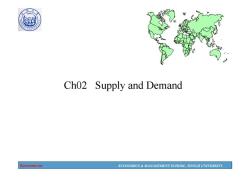
1907 Ch02 Supply and Demand Economics ECONOMICS MANAGEMENT SCHOOL,TONGJI UNIVERSITY
Economics ECONOMICS & MANAGEMENT SCHOOL, TONGJI UNIVERSITY Ch02 Supply and Demand
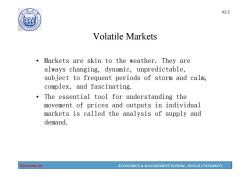
02-2 10 Volatile Markets Markets are skin to the weather.They are always changing,dynamic,unpredictable, subject to frequent periods of storm and calm, complex,and fascinating. The essential tool for understanding the movement of prices and outputs in individual markets is called the analysis of supply and demand. Economics ECONOMICS MANAGEMENT SCHOOL,TONGJI UNIVERSITY
Economics ECONOMICS & MANAGEMENT SCHOOL, TONGJI UNIVERSITY 02-2 Volatile Markets • Markets are skin to the weather. They are always changing, dynamic, unpredictable, subject to frequent periods of storm and calm, complex, and fascinating. • The essential tool for understanding the movement of prices and outputs in individual markets is called the analysis of supply and demand
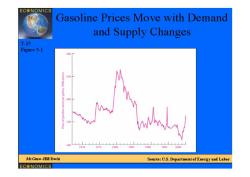
EC年NOMICS Gasoline Prices Move with Demand and Supply Changes T-15 Figure 3-1 300 250 200 g70 19w5 1990 19952000 c Graw-五0wi Source:U.S.Department of Energy and Labor EC米NOMICS|
Economics ECONOMICS & MANAGEMENT SCHOOL, TONGJI UNIVERSITY 02-3 Gasoline Prices Move with Demand and Supply Changes
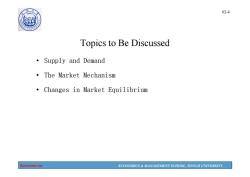
02-4 0 砂 Topics to Be Discussed ·Supply and Demand ·The Market Mechanism Changes in Market Equilibrium Economics ECONOMICS MANAGEMENT SCHOOL,TONGJI UNIVERSITY
Economics ECONOMICS & MANAGEMENT SCHOOL, TONGJI UNIVERSITY 02-4 Topics to Be Discussed • Supply and Demand • The Market Mechanism • Changes in Market Equilibrium
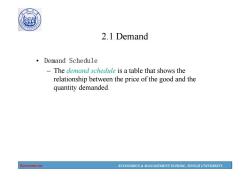
1907 2.1 Demand ·Demand Schedule The demand schedule is a table that shows the relationship between the price of the good and the quantity demanded. Economics ECONOMICS MANAGEMENT SCHOOL,TONGJI UNIVERSITY
Economics ECONOMICS & MANAGEMENT SCHOOL, TONGJI UNIVERSITY • Demand Schedule – The demand schedule is a table that shows the relationship between the price of the good and the quantity demanded. 2.1 Demand
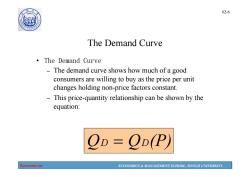
02-6 0 The Demand Curve ·The Demand Curve The demand curve shows how much of a good consumers are willing to buy as the price per unit changes holding non-price factors constant. This price-quantity relationship can be shown by the equation: 2D=QD(P Economics ECONOMICS MANAGEMENT SCHOOL,TONGJI UNIVERSITY
Economics ECONOMICS & MANAGEMENT SCHOOL, TONGJI UNIVERSITY 02-6 The Demand Curve • The Demand Curve – The demand curve shows how much of a good consumers are willing to buy as the price per unit changes holding non-price factors constant. – This price-quantity relationship can be shown by the equation: QD QD(P)
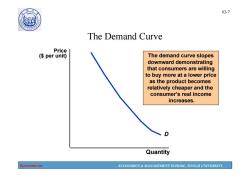
1907 02-7 The Demand Curve Price (per unit) The demand curve slopes downward demonstrating that consumers are willing to buy more at a lower price as the product becomes relatively cheaper and the consumer's real income increases. Quantity Economics ECONOMICS MANAGEMENT SCHOOL,TONGJI UNIVERSITY
Economics ECONOMICS & MANAGEMENT SCHOOL, TONGJI UNIVERSITY 02-7 D The demand curve slopes downward demonstrating that consumers are willing to buy more at a lower price as the product becomes relatively cheaper and the consumer’s real income increases. Quantity Price ($ per unit) The Demand Curve
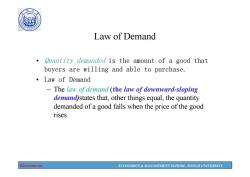
0 Law of Demand Quantity demanded is the amount of a good that buyers are willing and able to purchase. ·Law of Demand -The law of demand (the law of downward-sloping demandstates that,other things equal,the quantity demanded of a good falls when the price of the good rises. Economics ECONOMICS MANAGEMENT SCHOOL,TONGJI UNIVERSITY
Economics ECONOMICS & MANAGEMENT SCHOOL, TONGJI UNIVERSITY Law of Demand • Quantity demanded is the amount of a good that buyers are willing and able to purchase. • Law of Demand – The law of demand (the law of downward-sloping demand)states that, other things equal, the quantity demanded of a good falls when the price of the good rises
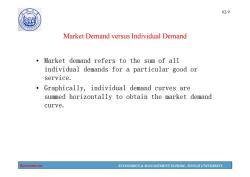
190 02-9 砂 Market Demand versus Individual Demand Market demand refers to the sum of all individual demands for a particular good or service. Graphically,individual demand curves are summed horizontally to obtain the market demand curve. Economics ECONOMICS MANAGEMENT SCHOOL,TONGJI UNIVERSITY
Economics ECONOMICS & MANAGEMENT SCHOOL, TONGJI UNIVERSITY 02-9 Market Demand versus Individual Demand • Market demand refers to the sum of all individual demands for a particular good or service. • Graphically, individual demand curves are summed horizontally to obtain the market demand curve
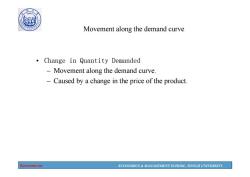
10 Movement along the demand curve Change in Quantity Demanded -Movement along the demand curve -Caused by a change in the price of the product. Economics ECONOMICS MANAGEMENT SCHOOL,TONGJI UNIVERSITY
Economics ECONOMICS & MANAGEMENT SCHOOL, TONGJI UNIVERSITY Movement along the demand curve • Change in Quantity Demanded – Movement along the demand curve. – Caused by a change in the price of the product
按次数下载不扣除下载券;
注册用户24小时内重复下载只扣除一次;
顺序:VIP每日次数-->可用次数-->下载券;
- 同济大学:《经济学》课程教学资源(教案讲义)Ch01 The Fundamentals of Economics(负责人:李永).pdf
- 同济大学:《经济学》课程教学资源(试卷习题)期终考试试卷(B卷)答案.pdf
- 同济大学:《经济学》课程教学资源(试卷习题)期终考试试卷(B卷)试题.pdf
- 同济大学:《经济学》课程教学资源(试卷习题)期终考试试卷(A卷)答案.pdf
- 同济大学:《经济学》课程教学资源(试卷习题)期终考试试卷(A卷)试题.pdf
- 安徽科技学院:《会计信息系统》课程教学资源(PPT课件)第七章 ERP应用概述.ppt
- 安徽科技学院:《会计信息系统》课程教学资源(PPT课件)第六章 会计信息系统审计.ppt
- 安徽科技学院:《会计信息系统》课程教学资源(PPT课件)第五章 会计信息系统的建设与管理.ppt
- 安徽科技学院:《会计信息系统》课程教学资源(PPT课件)第四章 其他业务核算子系统.ppt
- 安徽科技学院:《会计信息系统》课程教学资源(PPT课件)第三章 报表子系统.ppt
- 安徽科技学院:《会计信息系统》课程教学资源(PPT课件)第二章 账务处理子系统.ppt
- 安徽科技学院:《会计信息系统》课程教学资源(PPT课件)第一章 会计信息系统概述(主讲教师:王伟).ppt
- 安徽科技学院:《会计信息系统》课程教学资源(试卷习题)综合理论练习题及答案.doc
- 安徽科技学院:《会计信息系统》课程教学资源(试卷习题)复习思考题答案.doc
- 安徽科技学院:《会计信息系统》课程教学资源(试卷习题)练习题8.doc
- 安徽科技学院:《会计信息系统》课程教学资源(试卷习题)练习题7.doc
- 安徽科技学院:《会计信息系统》课程教学资源(试卷习题)练习题6.doc
- 安徽科技学院:《会计信息系统》课程教学资源(试卷习题)练习题5.doc
- 安徽科技学院:《会计信息系统》课程教学资源(试卷习题)练习题4.doc
- 安徽科技学院:《会计信息系统》课程教学资源(试卷习题)练习题3.doc
- 同济大学:《经济学》课程教学资源(教案讲义)Ch02-2 Applications of Supply and Demand.pdf
- 同济大学:《经济学》课程教学资源(教案讲义)Ch03 Demand and Consumer Behavior.pdf
- 同济大学:《经济学》课程教学资源(教案讲义)Ch04 Producer Behavior.pdf
- 同济大学:《经济学》课程教学资源(教案讲义)Ch05 Analysis of Cost.pdf
- 同济大学:《经济学》课程教学资源(教案讲义)Ch06-1 Analysis of Perfectly Competitive Markets.pdf
- 同济大学:《经济学》课程教学资源(教案讲义)Ch06-2 Imperfect Competition.pdf
- 同济大学:《经济学》课程教学资源(教案讲义)Ch07 General Equilibrium and Economic Efficiency.pdf
- 同济大学:《经济学》课程教学资源(教案讲义)Ch08 Market For Factors of Production.pdf
- 同济大学:《经济学》课程教学资源(教案讲义)Ch10 Overview of Macroeconomics.pdf
- 同济大学:《经济学》课程教学资源(教案讲义)Ch09 Externalities and Public Goods.pdf
- 同济大学:《经济学》课程教学资源(教案讲义)Ch11 National Income Accounting.pdf
- 同济大学:《经济学》课程教学资源(教案讲义)Ch12-1 Consumption and Investment.pdf
- 同济大学:《经济学》课程教学资源(教案讲义)Ch12-2 The Determination of Equilibrium Output.pdf
- 同济大学:《经济学》课程教学资源(教案讲义)Ch13 Money Market Equilibrium.pdf
- 同济大学:《经济学》课程教学资源(教案讲义)Ch14 Outputs and Money Market - IS-LM Model.pdf
- 同济大学:《经济学》课程教学资源(教案讲义)Ch15 Aggregate Demand And Supply.pdf
- 同济大学:《经济学》课程教学资源(教案讲义)Ch16 Economic Growth.pdf
- 吉林大学:《中央银行业务管理》课程教学资源(PPT课件)第一章 中央银行制度的形成和发展.ppt
- 吉林大学:《中央银行业务管理》课程教学资源(PPT课件)第七章 中央银行的其他业务.ppt
- 吉林大学:《中央银行业务管理》课程教学资源(PPT课件)第三章 中央银行业务活动的法规原则与资产负债表.ppt
